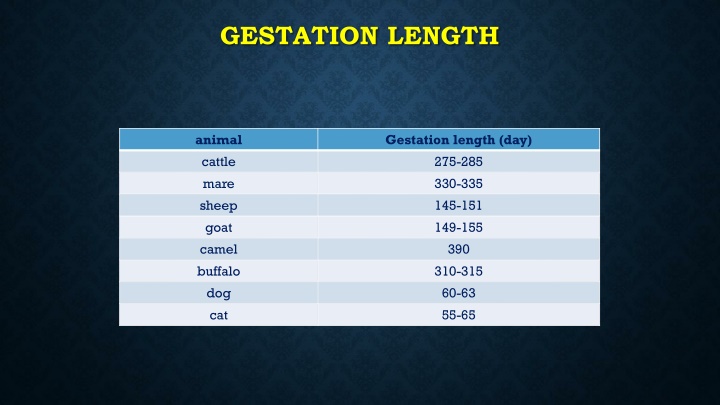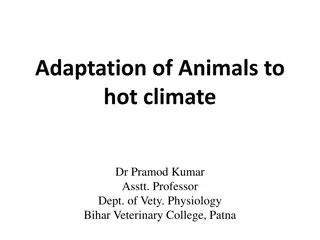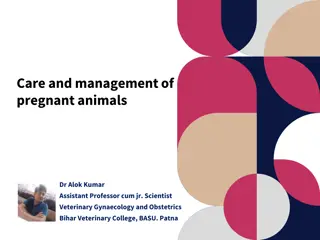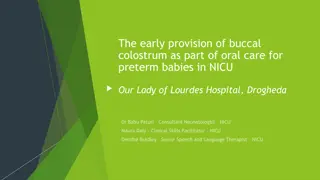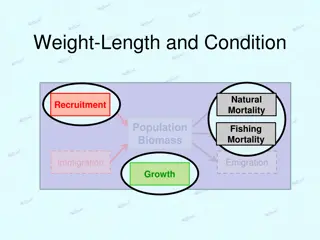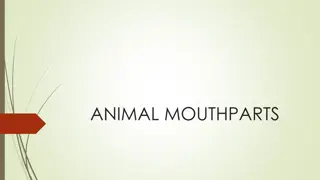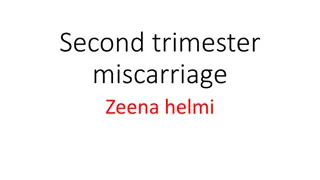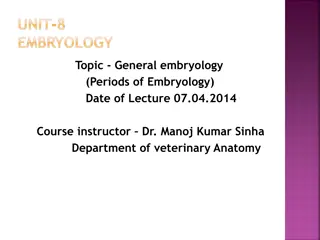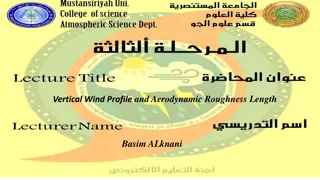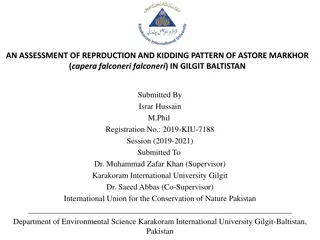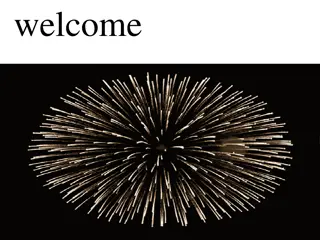Factors Influencing Gestation Length in Various Animals
This comprehensive guide explores the factors affecting gestation length in different animals, including cattle, mares, sheep, goats, camels, buffaloes, dogs, and cats. It covers factors that prolong gestation, such as genetic factors, deficiencies in minerals and vitamins, anomalies in the fetus, and the sex of the fetus. Additionally, it discusses factors that minimize gestation length, like twinning, the age of the dam, and diseases. The maintenance of pregnancy during the first month is also highlighted, emphasizing the importance of food supplementation and the primary attachment between the fetal membrane.
Download Presentation

Please find below an Image/Link to download the presentation.
The content on the website is provided AS IS for your information and personal use only. It may not be sold, licensed, or shared on other websites without obtaining consent from the author.If you encounter any issues during the download, it is possible that the publisher has removed the file from their server.
You are allowed to download the files provided on this website for personal or commercial use, subject to the condition that they are used lawfully. All files are the property of their respective owners.
The content on the website is provided AS IS for your information and personal use only. It may not be sold, licensed, or shared on other websites without obtaining consent from the author.
E N D
Presentation Transcript
GESTATION LENGTH animal cattle mare sheep goat camel buffalo dog cat Gestation length (day) 275-285 330-335 145-151 149-155 390 310-315 60-63 55-65
GESTATION LENGTH The factors which affect on gestation length
PARTURITION Stress factor
GESTATION LENGTH The factors which prolong the gestation length Genetic factors Species (cattle and mare) Breed (Holstein 275, Brahman 295) Type of fetus (mare pregnant with foal or mule) Inbreeding Inbreeding mating in swine prolong the gestation length 2-4 weeks Deficiencies in minerals especially iodide Induced and normal goiter prolong the gestation length 4-10 days
GESTATION LENGTH The factors which prolong the gestation length Deficiencies in vitamin A Deficiencies in vitamin A in ewes prolong the gestation length 1-4 weeks Anomalies in fetus Defect or anomalies in fetus pituitary gland Defect or anomalies in fetus adrenal gland Sex of the fetus In cows, the male fetus prolong the gestation length 1 week
GESTATION LENGTH The factors which prolong the gestation length Dead fetus Mummified fetus prolong the gestation length Induce prolonging in gestation length Experimentally by injection of progesterone
GESTATION LENGTH The factors which minimize the gestation length Twining In cows the twining decrease the gestation length 3-6 days The age of dam In cows the first and second pregnancy shorter than the 3ed and 4th one Diseases For placenta or uterus (abortion) For fetus (abortion) Stress factor and general disease
GESTATION LENGTH The factors which minimize the gestation length Hyper atrophy of adrenal gland Hormonal treatment ACTH Prostaglandin Estrogen
MAINTENANCE OF PREGNANCY First month of pregnancy Food supplementation Yolk sac, uterine milk and the primary attachment between the fetal membrane Prevention of luteolysis Maternal recognition of pregnancy (interferon) Pregnancy-specific protein, protein B may help maintain the corpus luteum of pregnancy in cows and ewes. Cervix closure and uterine relaxation Progesterone Immune rejection Placenta antigenicity, progesterone and interferon
MAINTENANCE OF PREGNANCY Second stage of pregnancy Food supplementation Development of placenta Thyroid, parathyroid, adrenal cortex, and other endocrine glands Produce secondary hormones of reproduction are important to maintenance metabolic state in mother and proper fetal development Second source for progesterone Ewe depend on placenta especially after day 50 Cow after 5th or 6th month depend on corpus luteum and placenta Mare after day 40 it depend on accessory corpus luteum till day 150 will be depend on placenta Sow and doe depend completely on corpus luteum
MAINTENANCE OF PREGNANCY Fetus stage of pregnancy till parturition Food supplementation Development of placenta High amount of progesterone to maintain pregnancy Progesterone from placenta (cow) accessory corpus luteum (mare) Increasing in the estrogen (the source of estrogen is placenta) Increase the uterine blood flow (important for nutrition, gas exchange and waste excretion and fetal development) Regulator for fetal growth and tissue differentiation Synergize with progesterone in development and preparation of the mammary gland
MAINTENANCE OF PREGNANCY Fetus stage of pregnancy till parturition The effect of relaxin and relaxin like factors produced by the corpus luteum (sow and cow) and the placenta (mare) Softening of connective tissue, which permits the uterine muscles to stretch to accommodate the growing fetus Expansion for the pelvic canal particularly during late gestation
PREGNANCY DIAGNOSIS Cessation of estrus External observation (abdomen, udder, vulva) External Ballottement Progesterone Analysis of Milk or Serum Pregnancy-associated Proteins (protein B) Ultrasonography Trans rectal palpation
TRANS RECTAL PALPATION Positive signs of pregnancy Palpation of the chorio-allantoic membrane by the membrane slip technique Palpation of the amniotic vesicle Palpation of the fetus Palpation of the placentomes
TRANS RECTAL PALPATION Additional findings may support pregnancy and may be useful in estimating gestational age Location of the uterus and cervix Thinning of the middle uterine artery wall, and palpation a pulse in it Size of the uterine horn and discrepancy in size of the uterine horns Presence of fluid in the uterus
TRANS RECTAL PALPATION The size of fetus according to the gestation age (cow)
PREGNANCY DIAGNOSIS The finding according to the gestation age Real time ultrasound (direct imaging) 13 21 Failure to return to estrus and persistence of CL 21 Progesterone concentration in plasma or milk 21 24 Assay of pregnancy specific protein B (PSPB) or pregnancy-associate glycoprotein (bPAG) 24 Palpation of the allantoic chorion ( membrane slip ) 33
TRANS RECTAL PALPATION The finding according to the gestation age Unilateral enlargement of horn and disparity in size, thinning of the uterine wall, fluid-filled fluctuation of enlarged horns 35 Palpation of the early fetus when amnion loses its turgidity 45 60 Palpation of placentomes 80 Hypertrophy of the middle uterine artery 85 Estrone sulphate in blood and milk 105 Palpation of fetus 120
